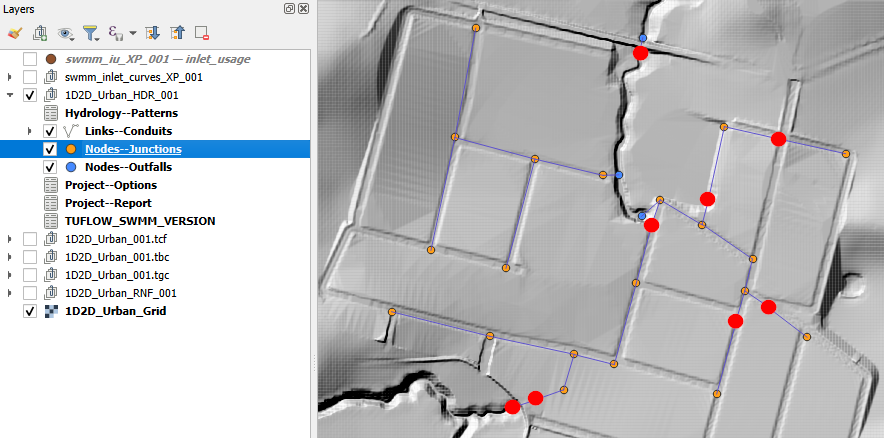XPSWMM Conversion Reconfigure SWMM Junctions
Bulk Update SWMM Nodes--Junctions Attributes
The following GIS feature updates to the Nodes--Junctions attributes will finalize the SWMM portion of the TUFLOW model. This is typically the final step in the model building process, as the recommended attributes for a junction node vary depending on whether the node is associated with inlet usage connections, 1D/2D culvert connections, and SWMM hydrology sub-catchments.
- In the QGIS Layers panel, select (left click) Nodes--Junctions and toggle on editing.
- In the Processing Toolbox, select the 'Edit Features In-Place' tool. This allows the editing of an existing layer, instead of the creation of a new layer.
- Go to TUFLOW >> SWMM in the processing tool list and select the 'Junctions - Set attributes' processing tool. This opens the dialog shown below.
- Input Subcatchment layers: If available, select Hydrology--Subcatchments.
- Input Inlet Usage Layers: If available, select the inlet usage layer (e.g. swmm_iu_XP_001).
- Input BC Connection Layers: If available, select the 2d_bc connection layer (e.g. 1D2D_Urban_001_2d_bc_L).
- General Options:
- Maximum Depth Option (Ymax): 'Leave as is (applies to edit in place only)'
- Nodes receiving subcatchment flows option (if connected to 2D): 'Based on options selected below'
- Nodes connected to 2D without Inlets (through embankment culvert):
- Ysur: 0
- Area of ponding: This value should match the 2D cell area associated with 1D/2D culvert connections (100 in the example dataset).
- Nodes connected to 2D with Inlets (underground pipe network):
- Maximum depth (Ymax) option: 'Use global option'
- Ysur: 0
- Area of ponding: This value should match the 2D cell area associated with the Inlet Usage connections (25 in the example model).
- Nodes without 2D Connection (underground pipe network):
- Surcharge Depth: This value should be a value higher than any expected water level in the model (99 in the example model).
- Area of ponding: 1
- Select 'Modify All Features'. Once the tool has finished, click 'Close'.
- Turn off editing to save the edits.
- View the attributes within Nodes--Junctions to verify the data processing has been completed correctly.
For a summary of the attributes associated with the Nodes--Junctions layer, refer to TUFLOW 2023-03-AD Release Notes (Table A.30) and the SWMM Reference Manual - Volume 2 (Hydraulics).
Selectively Update SWMM Nodes--Junctions Attributes
The final step in setting the Nodes--Junctions attributes requires updating the Ymax (maximum depth) attribute to zero (0) for the nodes within Nodes--Junctions that are not connected to the 2D surface via a Pipe Network Pit (Inlet Usage) connection point. Setting the value to zero adjusts the junction node's Ymax to match the distance from its invert to the top of the highest connecting link.
We can implement this update using a point selection workflow similar to the one described in the 'Correct the SWMM Nodes--Junction/Outfall Model Design' section.
- In the QGIS Layers panel, select (left click) Nodes--Junctions and toggle on editing.
- Use the 'Select Features' tool to select all nodes included in the Nodes--Junctions layer. When selected, this will change their color to bright yellow.
- In the Processing Toolbox, go to 'Vector Selection' and select 'Select within distance'. This opens the dialog shown below.
- Select features from: Nodes--Junctions (this is prepopulated as Nodes--Junctions is the active dataset).
- By comparing to the features from: Click the dropdown menu and select the inlet usage layer (e.g. swmm_iu_XP_001).
- Where the features are within: '0.1 meters'.
- Modify current selection by: 'removing from current selection'.
- Click 'Run'. Once the tool is finished, click 'Close'.
- In the QGIS Layers panel, right click Nodes--Junctions and select 'Open Attribute Table'.
- In the attribute table, only some of the junction nodes will be selected. To update the Ymax for the selected nodes:
- Set the target update column to Ymax.
- In the expression box, set the update value to 0.
- Click 'Update Selected'.
- Close the attribute table.
- Toggle editing off to save the edits to Nodes--Junctions.
For the provided example dataset, the above workflow should have updated the Ymax value for the junction nodes highlighted red in the image below.

Save the QGIS Workspace
In preparation for the next steps of the conversion process, ensure your QGIS workspace has been saved.
- In QGIS, go to Project > Save from the top dropdown menu options.
| Up |
|---|
| Up |
|---|